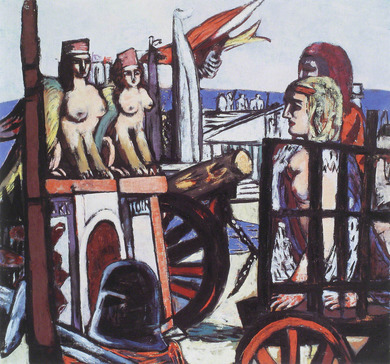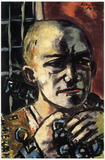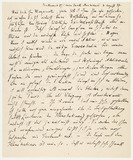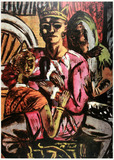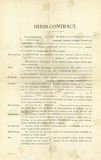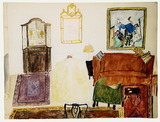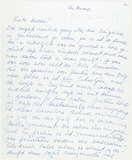Max Beckmann: Abtransport der Sphinxe [Transporting the Sphinxes], painting (1945)
Max Beckmann: Abtransport der Sphinxe [Transporting the Sphinxes], painting (1945)
Nun naht langsam das Ende. Engländer bei Wesel über den Rhein […] Morgens erstmalig an den „Sphynxen“.
[The end is close now. The English are at Wesel on the Rhine […] Was on the "Sphynxes" for the first time in the morning. (ed. trans.)]
Max Beckmann in a diary entry dated 25 March, 1945
Max Beckmann' s inspiration for this painting came from two individual sphinxes on the gate pillars at the Plantageparklaan entrance of the Wertheim Park in Amsterdam, although this inspiration was not relevant to the meaning of the painting. More importantly, he created the painting in the last few months of the Second World War. He worked on the painting until 2 October.
The scene shows a beach, with the deep blue sea in the background under a clear sky. A figure with a helmet and sword in the foreground indicates the warlike character of the scene, which principally affects two living sphinxes on a "triumphal arch" and another one on a cart behind bars, two of them free, one imprisoned and with an accordingly grievous expression. Their blonde hair and bloody paws make the viewer suspect that they represent Germany, while the "triumphal arch", its lettering ([P]ARK TUIN), the sphinxes sitting proudly on it, reminiscent of those in the Wertheim Park, and the flag behind them indicate the Netherlands, but defeat on one side and victory on the other is definite.
Helmuth Lütjens, who later bought the painting, said the following about it: "It is Beckmann's image of peace". The painter did not depict a real situation, but turned the end of the War into an allegorical scene in which he used the dangerous sphinx as a familiar mythological figure - based on the purely decorative sphinxes in the park in Amsterdam. However, again here, he unexpectedly converted the everyday into something important.
Further reading:
Lenz, Christian: Schön und schrecklich wie das Leben. Die Kunst Max Beckmanns 1937 bis 1945. In: Max Beckmann. Exil in Amsterdam. Ausstellungskatalog. Amsterdam / München: Hatje Canz 2007/2008, S. 33-107

